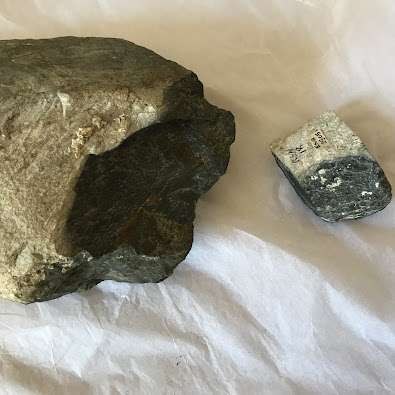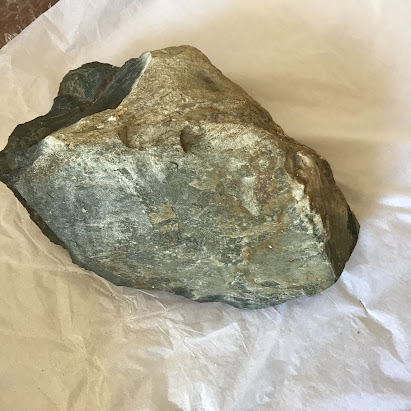Reproduced from the article. Key locations in the fanciful Waun Mawn narrative. There are many more rocky outcrops than those shown. Note that there were no sampling points close to Waun Mawn -- a serious research defect.
Well, it's always nice to be vindicated. I said from the beginning that the Waun Mawn narrative developed by Parker Pearson et al was not far short of being an elaborate hoax, and so it has proved. Virtually everything that I said in my Waun Mawn article (now read by almost 5,000 people) has been proved correct, by the very same people who have promoted the "lost circle" fantasy so energetically over the past few years. Just a reminder of what I said, on the basis of hard evidence on the ground and a knowledge of the local topography and geology:
https://www.researchgate.net/publication/345177590_Waun_Mawn_and_the_search_for_Proto-_Stonehenge

Anyway, a new article has appeared on Researchgate over the last few days -- it is due to be published in October 2022. It is one of the most futile and bizarre papers I have ever seen in a learned journal. It is nonetheless a very important paper, not because it contains anything unexpected, but because it finally demonstrates that the Waun Mawn "proto-Stonehenge" fantasy is dead and buried, with not a shred of evidence to support it. That is in spite of the frantic efforts of the people who wrote this paper. It is a highly complex and technical piece of work, but its findings are essentially very simple indeed.
First, the details:
Bevins, R.E., Pearce, N.J.G., Parker Pearson, M., Ixer, R.A., 2022. Identification of the source of dolerites used at the Waun Mawn stone circle in the Mynydd Preseli, west Wales and implications for the proposed link with Stonehenge. Journal of Archaeological Science: Reports 45 (2022) 103556.
Abstract
A Neolithic stone circle at Waun Mawn, in the Mynydd Preseli, west Wales, has been proposed as the original location of some dolerite megaliths at Stonehenge, including one known as Stone 62. To investigate this hypothesis, in-situ analyses, using a portable XRF, have been obtained for four extant non-spotted doleritic monoliths at Waun Mawn, along with two weathered doleritic fragments from a stonehole (number 91). The data obtained have been compared to data from spotted and non-spotted dolerite outcrops across the Mynydd Preseli, an area known to be the source of some Stonehenge doleritic bluestones, as well as data from i11-sint analysis of Stone 62 (non-spotted dolerite) and ex-situ analysis of a core taken from Stone 62 in the late 1980's.
Recently, Stone 62 has been identified as coming from Garn Ddu Fach, an outcrop some 6.79 km to the east southeast of Waun Mawn. None of the four dolerite monoliths at Waun Mawn have compositions which march (sic) Stonehenge Stone 62, and neither do the weathered fragments from stonehole 91. Rather the data show that the Waun Mawn monoliths, and most probably the weathered stonehole fragments, can be sourced to Cerrig Lladron, 2.37 km southwest of Waun Mawn, suggesting that a very local stone source was used in construction of the Waun Mawn stone circle. It is noted that there is evidence that at least eight stones had been erected and subsequently removed from the Waun Mawn circle but probability analysis suggests strongly that the missing stones were also derived, at least largely, from Cerrig Lladron.
-----------------------
Note, at the outset, that the authors assume there was a Neolithic stone circle at Waun Mawn. They blame others for identifying it as a lost circle, even though the majority view in the older literature is that there was no stone circle here. The pretence is pretty outrageous, and confusing too, since MPP himself has admitted that there probably never was a stone circle there, although our heroic ancestors might well have "intended to build one."
As I have pointed out over and again, there is just no evidence of sockets deep enough to have held standing stones, and for the authors to pretend, in his new paper, that a Waun Mawn stone circle is an established fact is disingenuous.
Another shameless stunt pulled by the authors is the pretence that the media are responsible for the wildly exagerrated claims made about Waun Mawn. The inflated claims made about the site are owned by Parker Pearson and his cronies, and there is no way that they can avoid responsibility for the hype and the other nonsense disseminated by TV programmes and in the press.
Anyway, back to work. Our heroic researchers set out to find out where the four stones at Waun Mawn have come from, and whether any link can be established with Stonehenge. Using portable X-ray equipment they analysed a clutch of samples from Waun Mawn and from outcrops of unspotted dolerite which might have been sources for the present and assumed missing monoliths. After protracted and convoluted studies (which make up the bulk of this paper), and with very splendid graphics, they conclude that none of the preferred candidate outcrops has any link with Waun Mawn, but that the Waun Mawn stones and unspotted dolerite fragments have most likely come from Cerrig Lladron. Strangely, they only chose prominent tors and smaller crags as their sampling points, and omitted to test any of the dolerite outcrops in the vicinity of Waun Mawn itself. That is a serious error, and I do not think that the evidence presented shows any firm link at all with Cerrig Lladron; all the researchers have shown is that the unspotted dolerites at the site of the fantastical stone circle have probably come from western Preseli and most probably from within a stone's throw, which is what I have been telling them all the time. I am amazed that experienced geologists can have been so ignorant of the local geology and so blind to the blindingly obvious.
There is a digression to consider a possible link with Stonehenge stone 62 -- there is another paper on that, which we have already considered on this blog. There was no link between stone 62 and Waun Mawn, but MPP is obviously reluctant to let the matter go. Much ado about nothing, in that paper already published, and in this paper too.......
A huge amount of work has gone into the analyses of the Waun Mawn and rock outcrop surfaces, and I feel rather sorry for those who have spent thousands of pounds and wasted hundreds of hours in desperately seeking to prove what was always a crazy and thoroughly unscientific ruling hypothesis. Most readers of this paper will be superficially impressed by the complex graphs and graphics -- until they try and work out what they all mean.
There is one final twist. At the end of the paper the authors embark on a convoluted "statistical analysis" designed to determine the probability of our heroic ancestors hauling away all of the valuable stones to Stonehenge or some other convenient place, while leaving behind the four rather boring local stones made of unspotted dolerite. Talk about clutching at straws! This section comes over as more than a little pathetic, and the editor of the journal should have spared the authors' blushes by cutting it out.
So there we are then, as we say in Wales. The "astonishing" story of the lost circle of Waun Mawn, so lauded by Alice Roberts and much of the media, is dead and buried -- finally shown by the storytellers themselves to be unsupported by a single shred of evidence.
In spite of this gigantic loss of scientific credibility, the authors still insist, at the end of the paper, that there was a giant circle of stones at Waun Mawn, and that at least eight monoliths have been removed. They still insist that there were bluestone quarries that supplied monoliths to Stonehenge, and they still pretend that there is radiocarbon evidence at Rhosyfelin and Carn Goedog that supports the quarrying hypothesis. Shame on them. Shame on them too, for refusing to admit anywhere in this article that their ideas are disputed, and for refusing to cite my comprehensive Waun Mawn article published and heavily scrutinised on Researchgate. Sadly, we are looking at the work of a group of academics who live in a permanent fantasy world in which everything inconvenient is simply denied or ignored.
Where does this leave Parker Pearson and his merry band? I wouldn't mind betting that as we speak, they are dreaming up their next fairy tale...........
==========
PS. When the "lost circle" fantasy was unleashed on the world in February 2021 with a massive media blitz coordinated with the journal publishers, I responded with a review of the multi-authored article on the Academia web site. This is what I said:






































